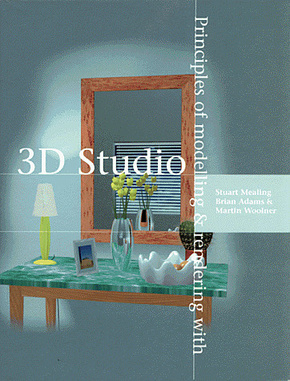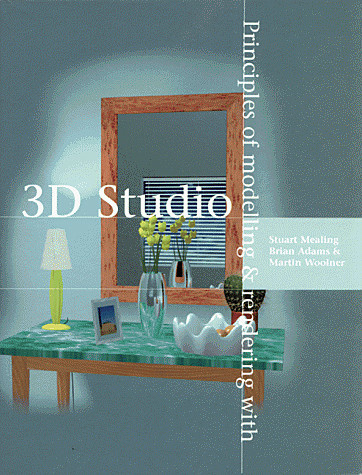Principles of Modelling and Rendering with 3D Studio (Book)
The use of three-dimensional modelling is developing rapidly in a number of important areas - product design, visualization and architecture for example. Designed to complement the existing reference books on Autodesk 3D Studio, this book primes the reader with an understanding of the fundamentals of 3D computer modelling, rendering and animation.
Edition
Stuart Mealing, Brian Adams & Martin Woolner
The authors are colleagues at the University of Plymouth (Exeter) and members of the Centre of Visual Computing. Stuart Mealing has a BA (Hons) in Fine Art and an MA in Computing in Design, Brian Adams has a BA (Hons) and a MDes(RCA) in Ceramics, Martin Woolner has a BA (Hons) in Sculpture and a MDes(RCA) in Furniture Design. Between them, they have a broad ranging knowledge of both the practice and theory of 3D computer modelling and have published and exhibited widely in the UK and abroad. Brian and Martin are particularly involved with designer-maker practice and use 3D Studio on a daily basis. Other books by Stuart are: The Art & Science of Computer Animation, Mac3D and Computers & Art.
1 INTRODUCTION
PART ONE: THEORY
2 THE WORLD OF 3D 3
2.1 What is modelling? 3
2.2 Navigating a 3-D computer world 4
2.3 What is rendering? 6
2.4 The role of the designer 8
3 APPLICATIONS 9
3.1 Architecture 10
3.2 3-D Design 11
3.3 Engineering 12
3.4 Simulation 13
3.5 Medical 17
3.6 TV graphics 18
3.7 Special effects 20
3.8 Art 22
3.9 Film animation 22
3.10 Archaeology 23
3.11 Education 24
3.12 Games 26
3.13 Virtual reality 27
4 FUNDAMENTALS: MODELLING 29
4.1 Display 30
4.2 Coordinates 30
4.2.1 Relative and absolute 32
4.2.2 Cartesian coordinates 33
4.2.3 Polar and spherical coordinates 33
4.2.4 Homogenous coordinates 34
4.3 Raster 34
4.4 Vector 35
4.5 Splines 35
4.6 Modelling 36
4.6.1 Methods 37
4.6.1.1 B-rep 37
4.6.1.2 Primitives 38
4.6.1.3 Swept forms 38
4.6.1.3.1 Spun 38
4.6.1.3.2 Extruded 39
4.6.1.3.3 Freeform 41
4.6.1.4 Lofted 41
4.6.1.5 Skin 41
4.6.1.6 CSG 42
4.6.1.7 Voxels 44
4.6.1.8 Fractals 45
4.6.1.9 Particles 45
4.6.1.10 Grammar-based 46
4.6.2 Joints 47
4.6.3 Flexibility 47
4.6.4 Deformation 48
4.6.5 Editing forms 48
4.7 Viewing models 49
4.7.1 Legibility 49
4.7.2 Wireframe 50
4.7.3 Hidden line 50
4.7.4 Depth cuing 52
4.7.5 Solid 52
4.7.5.1 Coded and lighted 53
4.7.6 Perspective 53
5 FUNDAMENTALS: RENDERING 57
5.1 Light sources 57
5.2 Lighting models 58
5.2.1 Lambert 58
5.2.2 Gouraud 59
5.2.3 Phong 59
5.2.4 Blinn 60
5.2.5 Ray tracing 60
5.2.6 Radiosity 60
5.2.7 Photo-realistic 61
5.2.8 Specialized 61
5.3 Shadows 62
5.4 Surface characteristics 63
5.4.1 Procedural and non-procedural 63
5.4.2 Texture mapping 63
5.4.2.1 Dirt 64
5.4.3 Solid texture 64
5.4.4 Bump mapping 64
5.4.5 Image mapping 66
5.4.6 Reflection mapping 66
5.5 Artefacts 66
5.6 Current research 68
6 FUNDAMENTALS: ANIMATION 69
6.1 Frame rate 70
6.2 Keyframe 70
6.3 Timeline 71
6.4 Scripted 71
6.5 Kinematic 72
6.5.1 Inverse kinematics 72
6.6 Dynamic 72
6.6.1 Inverse dynamics 73
6.7 Rule based 73
6.8 Assistance 74
6.9 Hierarchies 74
6.10 Metamorphosis 74
6.11 Organisation 75
7 PRACTICAL ISSUES FOR 3-D WORK 77
7.1 The operating system 77
7.2 Hardware elements 78
7.2.1 CPU 78
7.2.2 Memory 80
7.2.3 Storage 81
7.2.4 I/O 83
7.2.5 Networking 84
7.3 Expansion 85
7.3.1 Accelerators 85
7.4 Control hardware 86
7.5 Files 87
7.6 Compression 87
7.6.1 JPEG 89
7.6.2 MPEG 89
7.6.3 H.261 90
7.6.4 IFS 90
7.7 Customization 90
7.8 Expense 92
7.8.1 Time 93
7.8.2 Money 93
7.9 Ergonomics 95
8 COMMUNICATING WITH THE COMPUTER 97
8.1 Input devices 97
8.1.1 Keyboard 98
8.1.2 Mouse (+ variations) 99
8.1.3 2-D graphic tablet 100
8.1.4 3-D digitiser 101
8.1.5 Touch screen 101
8.1.6 Scanner 102
8.1.7 New input devices 103
8.1.8 Video 103
8.1.8.1 Still camera 104
8.1.8.2 Live camera 104
8.1.8.3 VTR 105
8.2 Output devices 105
8.2.1 VDU 105
8.2.2 Printer 108
8.2.3 Plotter 110
8.2.4 VTR 110
8.2.5 Still camera 111
8.2.6 Film camera 112
8.3 The screen interface 112
9 DESIGN METHODOLOGY 117
9.1 Planning 117
9.1.1 'World' map 118
9.2 Matching methods to tools 119
9.3 The naming of parts 120
9.4 Salvation 121
9.5 Lateral thinking 122
9.6 Cheating 123
10 THE FUTURE 125
10.1 Virtual reality 126
10.2 Shared environments 128
10.3 Dynamics 129
10.4 Intelligent models 130
10.5 Digital dough 132
10.6 Catalogues 133
10.7 And finally 134
PART TWO: 3D STUDIO
11 3D STUDIO FOR DOS 135
11.1 Introduction 135
11.1.1 Hardware requirements 136
11.1.2 An overview and some basic principles 136
11.1.3 Grid and Snap 138
11.1.4 Undos and don'ts 138
11.1.5 The Axis 139
11.1.6 The Geometry 140
11.1.7 Saving Files 141
11.2 The 2D Shaper 142
11.2.1 The interface 142
11.2.2 Polygons 142
11.2.3 Adjusting polygons 144
11.2.4 Splining 145
11.2.5 Flat shapes 145
11.2.6 Preparing a shape for lofting 146
11.3 The 3D Lofting 147
11.3.1 Lofting 147
11.3.2 Lofting different shapes along a path 149
11.3.3 Deformation Tools 150
11.3.4 Previewing and creating 153
11.4 The 3D Editor 154
11.4.1 The interface 154
11.4.2 The graphic components of the 3D Editor 155
11.4.3 Display 155
11.4.4 Object colour 156
11.4.5 Selection Sets 156
11.4.6 3D Editor modelling 157
11.4.7 Combining, composing and altering 3D forms 158
11.4.8 Other models and methods 159
11.4.9 Lights 161
11.4.10 Adding materials in the 3D Editor 163
11.4.11 Applying materials 163
11.4.12 Mapping 164
11.4.13 Mapping coordinates 165
11.4.14 Cameras 166
11.4.15 Previewing the image 168
11.4.16 Rendering the image 169
11.5 The Keyframer 171
11.5.1 Directing the action: animation 171
11.5.2 Keys and keyframes 172
11.5.3 Paths 173
11.5.4 The Key Information dialog box 174
11.5.5 The Track Information dialog box 176
11.5.6 Morphing 177
11.5.7 Hierarchical Linking and Inverse Kinematics 177
11.5.8 Previewing an animation 178
11.5.9 Rendering an animation 179
11.5.10 The Video Post 180
11.6 The Materials Editor 181
11.6.1 How 3D Studio makes a material 181
11.6.2 The Interface 182
11.6.3 Attributes 183
11.6.4 Maps 184
11.6.5 Material Libraries 185
12 3D STUDIO MAX 187
12.1 Hardware requirements 187
12.2 The interface 188
12.3 Accessing commands 189
12.4 Creating objects 190
12.5 Transformations and modifications 192
12.6 The Modifier Stack 193
12.7 Different levels of object modification 193
12.8 Creating scenes, cameras and lights in IMAX 195
12.8.1 Cameras 195
12.8.2 Lights 195
12.9 Materials 196
12.10 Rendering a scene 198
12.11 Environmental effects 199
12.12 Special effects 199
12.13 Particle systems 201
12.14 Animation with MAX 201
13 3D STUDIO VIZ 205
13.1 CAD 205
13.2 Modelling 206
13.3 Backgrounds 206
13.4 Lights 207
13.5 Rendering and animation 207
14 3D STUDIO- CONCLUSIONS 209
15 CASE STUDIES 211
15.1 The Hall Table 211
15.2 The Teapot 216
15.2.1 The Cup and Saucer 220
15.3 The Arctic Cactus 221
15.4 The '3D' 225
APPENDIX 1: GLOSSARY OF TERMS 227
APPENDIX 2: FILE FORMATS 239
BIBLIOGRAPHY 241
INDEX 243




